Where do woodlice come from on the site and how to deal with them?
Among pests of garden plants, woodlice is known for its unpleasant appearance. In wet summer, it fills greenhouses, summer cottages, apartments. You can get rid of it with both chemical and folk remedies. And the methods of prevention will allow you to avoid meeting with the pest.
Woodlice is called so for a reason, she loves when it is too damp, the air is filled with moisture without a fresh breeze. Then the representative of crustaceans is at ease both in the greenhouse and in the garden. And there is enough food around.
Content:
- Biological features of woodlice
- Where do they come from in the greenhouse and in the garden
- What harm do woodlice bring
- Pest control chemicals
- The use of folk remedies in the fight against wood lice
Biological features of woodlice
Even in appearance, woodlice resembles crabs, crayfish - the chitinous cover casts all shades of gray. During the growth of wood lice, they shed their old shell, and a delicate chitinous cloak appears in its place. The covering, like the oblong body of the crustacean, is divided into plates. There are no claws, but seven pairs of legs help a small, up to two centimeters long, lover of dampness to move quickly. The last pair is used for support and protection from enemies.
The pest is guided with the help of a long mustache.
Eyes are located on the sides of the front of the body. During the detection of danger, the crustacean pretends to be dead, twisting into a motionless ball. Woodlice are crepuscular, nocturnal animals. During the day they can hide under a stone, a leaf, and as soon as the sun hides, it is time for their meal.
Since woodlice live on land, and not in water, like their closest relatives, they tolerate dry summers well. Adaptation occurs due to air cavities in the body of crustaceans, resembling a trachea. The unpleasant appearance of the animal allows you to avoid its destruction by mechanical means - not everyone dares to touch the disgusting crustacean.
Where do they come from in the greenhouse and in the garden
There are several reasons for the appearance of wood lice on the site, in closed rooms:
- The ideal environment for them is humid. Excess moisture is formed not only due to endless rainfall, but due to the leakage of water pipes for watering the garden.
- Unventilated greenhouses with air humidity over 80-90 percent are the best place for wood lice to live and breed.
- Places for collecting garbage at their summer cottage can be an excellent hiding place for crustaceans.
- In compost pits, where the temperature inside does not rise above forty degrees, there is also tasty food for wood lice.
- Pests like to spend the day under the rubble of bricks, pieces of cellophane, in a heap of cut branches in the garden.
- Pests can get into the greenhouse in the spring when transferring land, humus, manure from the garden.
- Stagnant water in basins, flowerpots, buckets attracts crustaceans as the best place to live.
Woodlice live on the banks of rivers and lakes, but they also populate summer cottages, if they are comfortable there - there is where to hide and what to eat.
What harm do woodlice bring
In nature, there is enough food for animals - rotting plants, algae, tree bark, moss. Once in a vegetable garden or greenhouse, they go out at night to hunt for tender leaves of vegetables, spicy herbs. It is especially convenient for them to feast on those plants that are located close to the ground.
With large colonies, woodlice gnaw at the roots, which leads to the death of garden crops.
The main signs of damage by a pest include the appearance of gnawed holes and gnawed edges on the leaves. On greenhouse beds, the earth under the influence of crustaceans begins to compact. Because of this, the roots of vegetable crops suffocate from a lack of nutrients and oxygen.
Woodlice seem to be harmless, but fast-breeding individuals require more food. Therefore, the neglect of the site, greenhouses, a large number weeds will lead to a complete loss of the crop. In addition, pathogenic fungi, which crustaceans spread on their paws, will help to destroy vegetable crops. The apparent external harmlessness of woodlice will affect the state of the garden, greenhouses by the fact that your favorite plants will wither there, slowly die
Pest control chemicals
A feature of the use of pesticides to eliminate the pest is the reliability of the preparations, their high efficiency:
- In 48 hours after processing vegetable plantings with Fozalon, woodlice die. The advantage of the drug is its effect on pests even at low air temperatures. But the systematic use of a chemical can cause the development of resistance to it. When using a pesticide, care must be taken, as it belongs to highly toxic drugs.
- Spraying plants with Permethrin is used to combat harmful insects, including wood lice. The drug well destroys leaf-gnawing pests, and has a pronounced deterrent effect. The validity period of the funds is from fifteen to twenty days. The substance decomposes in the soil without adversely affecting plants. The pesticide is completely harmless to humans, but it causes irritation when it comes into contact with mucous membranes and skin.
- Metaldehyde damages the mucous membranes of crustaceans, which leads to their death. The pesticide in the form of a crystalline substance is scattered in the area of active life of woodlice.
Chemicals should be used in accordance with the instructions for use, taking precautions.
The use of folk remedies in the fight against wood lice
There are many ways to deal with wood lice that have been tried by summer residents for many years:
- In the area of accumulation of pests, table salt is poured or filled with a saturated solution of the substance. Care must be taken during the procedure, trying not to get on the fertile soil layer, otherwise you can destroy vegetable crops. A mixture of dry kvass in the amount of one hundred grams and half a liter of boiling water has a similar, pest-destroying property.
- The scattered powder of boric acid leads to the destruction of the chitinous cover of the animal. Such a solution is also effective: three grams of ground red pepper, crushed tobacco, soda ash are poured into a liter of water. The infusion is used to treat the areas of accumulation of woodlice.
- An excellent result in eliminating the pest from the garden or greenhouse will be the manufacture of traps. Wood lice like to crawl into potatoes with cut-out centers laid out along the beds. All that remains is to collect the "crop" of pests and destroy them.
- Wet rags and birch brooms are also bait for crustaceans. Hiding in them, woodlice are doomed to death: in the morning, summer residents collect and burn shelters they like to pests.
More information can be found in the video:
You can prevent the appearance of woodlice with proper vegetable care:
- First of all, regular weeding of the beds will free the area from weeds, and the plants from dangerous crustaceans.
- Excessive watering of vegetables in the greenhouse, its irregular airing contributes to the creation of conditions for the reproduction of the pest. It is possible to prevent its appearance by renewing the soil in greenhouses, greenhouses, without clogging it up with weeping, rotting remains of plants and debris. The introduction of tree bark and peat into the ground contributes to soil decay.
- To free the garden from pest settlements will help such actions as cleaning the site from heaps with rotten tops, damaged fruits and vegetables. Old stumps, rotting lumber residues are an excellent habitat for wood lice.
- For household waste, it is better to prepare special containers with a lid, taking them away from the summer cottage on time. And it is better to add manure to the compost pits, then the temperature inside them will rise over forty degrees Celsius. They will not be suitable for woodlice habitat.
- In order to prevent animals from attacking young plants, sprinkle metaldehyde between the beds in the spring.
The use of preventive measures against a crustacean pest is a real opportunity to help the plants in the garden to bring a rich harvest.



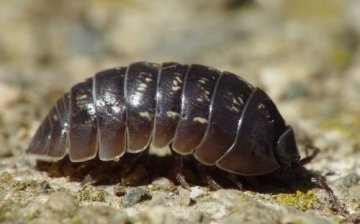
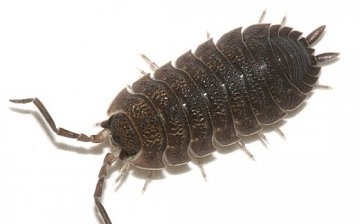

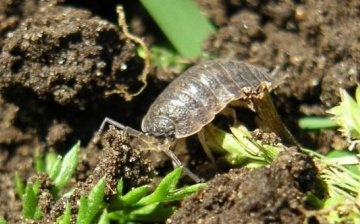
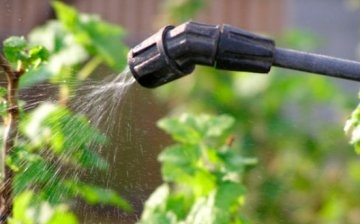
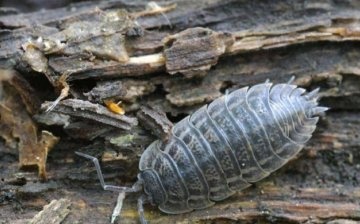







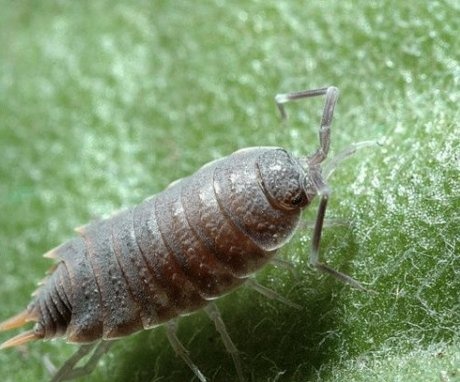

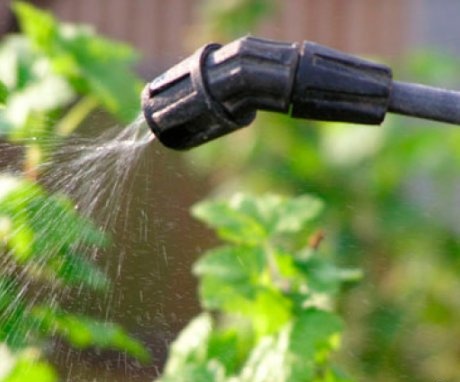
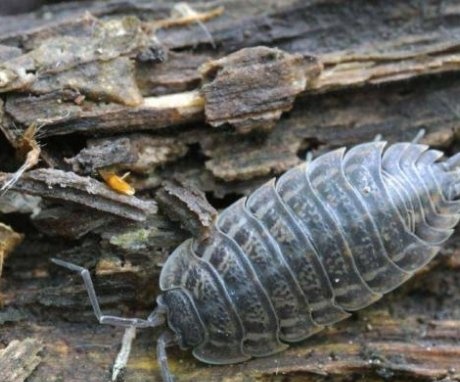
Last year, we ate Dutch cucumbers on woodlice in our garden. Those are just starting to emerge from the earth. Throw away 2 - 3 leaves, and the next day, everything has already been eaten. Moreover, those cucumbers that grew in the sun, all remained intact, and in the shade of the trees, everything was destroyed.
If wood lice appear, you need to look for moist, dark places under trees and in the area of buildings where they live and reproduce. There are not too many such places, therefore, with a certain diligence, it is not difficult to solve the problem with this pest.